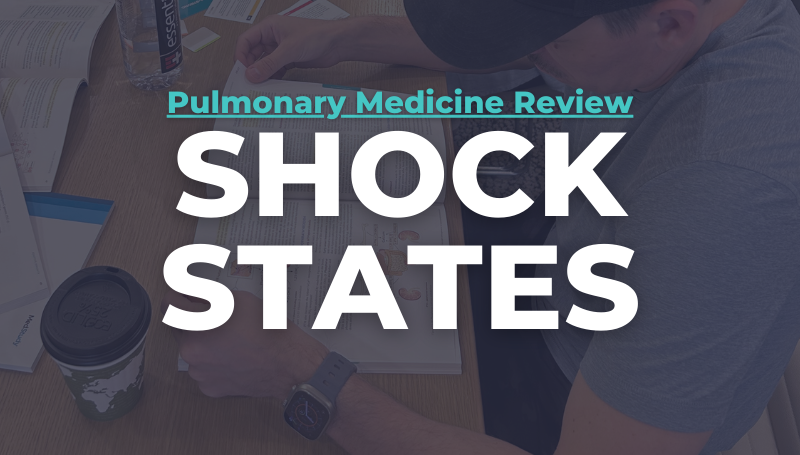Understanding Shock States: Review for Internists

Understanding the various shock states is crucial for any healthcare professional, especially those preparing for board exams or working in critical care settings. Differentiating between the types of shock—hypovolemic, cardiogenic, distributive, and obstructive—is essential for timely diagnosis and effective treatment.
In this blog, we'll explore the different shock states, using high-yield content from the Internal Medicine Core, a comprehensive learning tool designed to give you the knowledge you need to excel in your practice and on the boards. Be sure to stay until the end for shock state pearls from our Critical Care expert, Dr. Raj Dasgupta.
Review of shock states for internists
The content below is excerpted from the Internal Medicine Core > Pulmonary Medicine> Critical Care > Shock States. This MedStudy Core content was medically reviewed by Tony Hannaman, MD.
What is shock?
Shock is a circulatory system deficiency that leads to insufficient delivery of oxygen to tissues and may lead to organ dysfunction.
Types of shock
Types of shock include hypovolemic, cardiogenic, distributive, and obstructive. It is important to differentiate these.
Hypovolemic shock
Hypovolemic shock is due to loss of blood volume. It can be due to hemorrhage or severe volume depletion. Hemorrhage from the GI tract, trauma, ruptured aortic aneurysm, or ruptured ectopic pregnancy cause hypovolemic shock. Severe volume depletion can be caused by diarrhea, poor oral intake, vomiting, polyuria, and unreplaced insensible losses. Patients with hypovolemic shock are hypotensive and tachycardic. The skin may be cold or clammy. There is low urine output. Treat by administering isotonic saline and/or blood products, and correcting the underlying cause.
Cardiogenic shock
Cardiogenic shock is caused by failure of the pump function of the heart due myocardial infarction, myocarditis, cardiomyopathy, valve failure, bradycardia, arrhythmia, or hypertrophic cardiomyopathy.
The patient is hypotensive and heart rate varies depending on the cause but is usually rapid and faint. The skin is cool and mottled, jugular venous pressure (JVP) is elevated, and crackles are present on the lung examination. Peripheral edema may be present.
Chest radiograph typically shows pulmonary edema and cardiomegaly. ECG may show acute or evolving ischemic changes or arrhythmia (or may be normal). Cardiac enzymes may be elevated. Echocardiography is essential and may show decreased ejection fraction, structural abnormalities, valvular disease, and other abnormalities. In some cases, pulmonary artery (right heart) catheterization is performed and generally shows an elevated PCWP (usually > 15 mmHg) and a reduced cardiac output/index.
Management generally includes diuretics, vasopressors, supplemental oxygen, and sometimes mechanical ventilation. Ionotropic support with dobutamine or milrinone may be beneficial. Short-term mechanical assist devices include intraaortic balloon pumps and LV assist devices. For patients with acute coronary syndrome, management includes aspirin, heparin, β-blocker, statin, and consideration for PCI or CABG. Thrombolytic therapy can be used if revascularization procedures are not performed.
Distributive shock
Distributive shock is most commonly caused by septic shock but may also result from noninfectious causes (e.g., acute pancreatitis, burns, bowel obstruction), anaphylaxis, drug reactions, transfusion reactions, neurogenic shock, liver failure, and toxic shock syndrome.
With distributive shock, there is direct vasodilatation due to circulating bacterial endotoxin, other exogenous substances or toxins, and/or circulating inflammatory mediators. In addition, there is loss of responsiveness of vascular smooth muscle to vasoconstrictors that maintain tone. There is often loss of capillary integrity with third spacing of fluid.
Early in septic shock there is a hyperdynamic phase with tachycardia and hypotension, and skin is often warm and flushed. As shock progresses, there is hypoperfusion and often reduced cardiac contractility, and skin is often cool.
Fluid resuscitation is indicated, and, for sepsis, vasopressor support.
Obstructive shock
Obstructive shock is due to blocked circulation in the great vessels or the heart, with decreased ventricular preload or increased ventricular afterload. Decreased ventricular preload may be due to increased intrathoracic pressure from tension pneumothorax, mechanical ventilation, or status asthmaticus; decreased cardiac compliance from constrictive pericarditis or cardiac tamponade; and direct venous obstruction from intrathoracic tumor. Increased ventricular afterload may result from acute pulmonary embolism, acute pulmonary hypertension, and aortic dissection.
Physical findings vary depending on the etiology. Tension pneumothorax can cause unilaterally decreased breath sounds, tracheal shift, and tachycardia. Findings of air trapping may be detected on a ventilated patient with elevated auto-PEEP measured on end expiratory breath hold. Acute pericarditis and cardiac tamponade can cause chest pain, fever, pulsus paradoxus (> 20 mmHg decrease in normal inspiratory drop in blood pressure), and the Beck triad (JVP elevation, hypotension, and muffled heart sounds).
ECG may show ST-segment elevations in acute pericarditis or low voltage in pericardial effusion. Echocardiogram may show thickened pericardium and/or pericardial effusion with collapsed ventricles.
Treatment varies based on the underlying cause. Treat tension pneumothorax with tube thoracostomy and correction of conditions that led to its development. Treat pericardial tamponade with pericardiocentesis, which may be both diagnostic and therapeutic. For chronic pericardial effusion, a surgical pericardial window may be needed. Treat acute pulmonary embolism with hypotension that does not respond to IV fluid with thrombolytic therapy or mechanical embolectomy.
By mastering the nuances of hypovolemic, cardiogenic, distributive, and obstructive shock, you will be better prepared to tackle these challenges in both your board exams and clinical practice. The content covered here is just a glimpse of the high-yield material available in the Internal Medicine Core, to deepen your understanding and continue your review, be sure to explore the Pulmonary Medicine section of our Internal Medicine Core book set.
High-yield shock pearls with Dr. Raj
Continue your review of shock states with Dr. Raj Dasgupta, our Critical Care and Pulmonary Medicine expert. As the Pulmonary Medicine speaker for our Internal Medicine Review Courses, Dr. Raj created a video series packed with high-yield pearls on shock states to help internists master these essential topics. Watch his easy-to-remember videos covering Hypovolemic Shock, Cardiogenic Shock, Treatment of Septic Shock, Neurogenic Shock, and Anaphylactic Shock.


